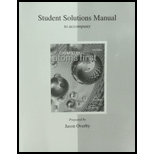
Concept explainers
Interpretation:
A balanced reaction for the given reactions has to be written.
Concept introduction:
- There is a law for conversion of mass in a
chemical reaction i.e., the mass of total amount of the product should be equal to the total mass of the reactants. - The concept of writing a balanced chemical reaction is depends on conversion of reactants into products.
- First write the reaction from the given information.
- Then count the number of atoms of each element in reactants as well as products.
- Finally obtained values could place it as coefficients of reactants as well as products.
Answer to Problem 26.33QP
The balanced reaction for the given reactions is
(a)
(b)
(c)
(d)
(e)
(f)
Explanation of Solution
(a)
Sodium metal reacts with water to produce sodium hydroxide and hydrogen gas.
Here, the reaction is unbalanced. So we need to balance it.
To balance the reaction, calculate the number of atoms present in left side and right side. Finally, obtained values could place it as coefficients of reactants as well as products.
(b)
An aqueous solution of
Here, the reaction is unbalanced. So we need to balance it.
To balance the reaction, calculate the number of atoms present in left side and right side. Finally, obtained values could place it as coefficients of reactants as well as products.
(c)
Solid
Here, the reaction is unbalanced. So we need to balance it.
To balance the reaction, calculate the number of atoms present in left side and right side. Finally, obtained values could place it as coefficients of reactants as well as products.
(d)
Solid
To balance the reaction, calculate the number of atoms present in left side and right side. Finally, obtained values could place it as coefficients of reactants as well as products. In this reaction equally conversion happened so that reaction is already balanced.
(e)
Solid
Here, the reaction is unbalanced. So we need to balance it.
To balance the reaction, calculate the number of atoms present in left side and right side. Finally, obtained values could place it as coefficients of reactants as well as products.
(f)
At normal temperatures sodium carbonate won’t go decomposition.
When we heat the solid
A balanced equation for the given reactions were written
(a)
(b)
(c)
(d)
(e)
(f)
Want to see more full solutions like this?
Chapter 26 Solutions
Student Solutions Manual For Chemistry: Atoms First
- Why do Selenium and tellurium occur in rare minerals?arrow_forwardWrite the reaction of lithium with cold water.2. Write the reaction of magnesium with steam.3. Write the reaction of calcium with cold water.4. Write the equation for the formation of lithiumhydride.5. Write the equation for the formation of calciumhydride.arrow_forwardWrite the overall balanced equation for cobalt (II) nitrate hexahydrate reacting with ammonium carbonate, conecntrated ammonia, hydrogen peroxide, and water to form [Co(NH3)4CO3]NO3.arrow_forward
 Chemistry: Principles and ReactionsChemistryISBN:9781305079373Author:William L. Masterton, Cecile N. HurleyPublisher:Cengage Learning
Chemistry: Principles and ReactionsChemistryISBN:9781305079373Author:William L. Masterton, Cecile N. HurleyPublisher:Cengage Learning Chemical Principles in the LaboratoryChemistryISBN:9781305264434Author:Emil Slowinski, Wayne C. Wolsey, Robert RossiPublisher:Brooks Cole
Chemical Principles in the LaboratoryChemistryISBN:9781305264434Author:Emil Slowinski, Wayne C. Wolsey, Robert RossiPublisher:Brooks Cole Chemistry: Principles and PracticeChemistryISBN:9780534420123Author:Daniel L. Reger, Scott R. Goode, David W. Ball, Edward MercerPublisher:Cengage Learning
Chemistry: Principles and PracticeChemistryISBN:9780534420123Author:Daniel L. Reger, Scott R. Goode, David W. Ball, Edward MercerPublisher:Cengage Learning General Chemistry - Standalone book (MindTap Cour...ChemistryISBN:9781305580343Author:Steven D. Gammon, Ebbing, Darrell Ebbing, Steven D., Darrell; Gammon, Darrell Ebbing; Steven D. Gammon, Darrell D.; Gammon, Ebbing; Steven D. Gammon; DarrellPublisher:Cengage Learning
General Chemistry - Standalone book (MindTap Cour...ChemistryISBN:9781305580343Author:Steven D. Gammon, Ebbing, Darrell Ebbing, Steven D., Darrell; Gammon, Darrell Ebbing; Steven D. Gammon, Darrell D.; Gammon, Ebbing; Steven D. Gammon; DarrellPublisher:Cengage Learning Chemistry by OpenStax (2015-05-04)ChemistryISBN:9781938168390Author:Klaus Theopold, Richard H Langley, Paul Flowers, William R. Robinson, Mark BlaserPublisher:OpenStax
Chemistry by OpenStax (2015-05-04)ChemistryISBN:9781938168390Author:Klaus Theopold, Richard H Langley, Paul Flowers, William R. Robinson, Mark BlaserPublisher:OpenStax ChemistryChemistryISBN:9781305957404Author:Steven S. Zumdahl, Susan A. Zumdahl, Donald J. DeCostePublisher:Cengage Learning
ChemistryChemistryISBN:9781305957404Author:Steven S. Zumdahl, Susan A. Zumdahl, Donald J. DeCostePublisher:Cengage Learning





